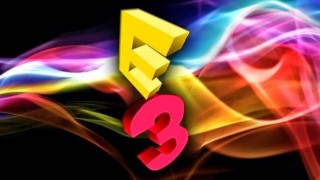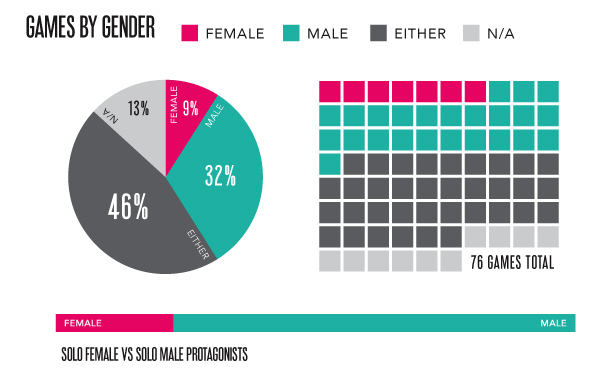
If you’ve been listening to the media reports recently, you’d be under the impression that E3 2015 was the year of gender equality; gameplay presentations were overflowing with female video game protagonists; and developers and hosts of the fairer sex (if that term is even permitted anymore) were rocking the conferences in style, showing their male counterparts how it’s truly done. Why would we come to such a conclusion? Because Anita Sarkeesian said so.
Just for the record, I’m pleased to see the video games industry open up to a wider audience, whoever that may be. The point, however, is that women have been making inroads into the games industry, gradually, over many years. This process took root long before Anita Sarkeesian swept in with her, as yet, unfinished Kickstarter project - Tropes vs. Women in Video Games. To suggest otherwise would be to make two egregious mistakes: apportion credit where credit is not due, and belittle the professional strives that women have made in the games industry.
The media stories came, thick and fast, after Sarkeesian’s non-profit organization, Feminist Frequency, published the following article: Gender Breakdown of Games Showcased at E3 2015.
It makes for a compelling read, but, also, a misleading one.
The Power of Groupthink
Even before the article’s publication, a slew of authors jumped on the PC bandwagon to uncritically regurgitate each other’s erroneous conclusions. Medium’s Adrian Chmielarz expertly pointed to the articles that demonstrated the groupthink mentality of the mainstream journalists:
IGN: “In addition to an increased number of female presenters, the games at this year’s E3 featured a large number of female lead characters...”
Guardian: “After years of being told that female characters don’t sell games or are too time-consuming to draw, E3 2015 provided a heartening influx of women in leading roles.”
Financial Post: “It seems the Electronic Entertainment Expo is no longer a man’s world. During this year’s video game extravaganza, a variety of women — virtual and otherwise — have been featured more prominently than in past years of the annual trade show where game makers highlight their forthcoming creations.”
Destructoid: “What is encouraging, however, is that this isn’t just a few scattered games, but a noticeable shift within the industry.”
Tech Times: “The result [of GamerGate]? A berth of new games, most of which were the latest installments of popular titles -including Assassin’s Creed: Syndicate and Fallout 4 — featured fleshed-out female protagonists, and a notable uptick of female representation at the press conferences themselves, both as presenters and journalists. The latter marked an important watershed, considering that there were more severed heads than female hosts and last year’s conference.”
GameZone: “Along with millions of you this week, I was glued to E3 coverage and one thing that stood out to me is that in the sea of games being showcased, this year seems to have been a boon for diversity and not just in the token femme fatale or the damsel in distress.”
The gushy list goes on and on, with Chmielarz pointing to additional examples from The Verge and Develop. In fact, I added the quotes from GameZone and Tech Times (after a minute or two of searching the web), simply to demonstrate that Chmielarz’s list represents a drop in the ocean.
The afore-mentioned quotes also illustrate how quickly these myths are transmitted between journalists, many of whom haven’t checked to see what the difference is between E3 2014 and E3 2015. They’ve been told what the narrative is, and they blindly run with it. It also shows a worrying mantra in journalism: because an argument happens to be “progressive,” it must be correct.
No Major Difference Between E3 2015 and E3 2014
While many media outlets proclaimed 2014 to be one of the worst years for gender equality at E3 - with outlets reporting on the industry’s “dismal state of character diversity” - this outlook has, all of a sudden, changed. But has it really?
Chmielarz goes on to perform his own investigation into the gender equality witnessed during E3 2015, compared to the gender equality of E3 2014. He looked at the female and male protagonists for the video games of E3 2015 and E3 2014, separating them into four main categories that covered females in both “big productions” and “smaller productions,” as well as female characters featured in “segments” of gameplay, and games where the main character’s gender was optional.
After scanning through a comprehensive list of video game titles, Chmielarz concluded there was virtually no difference between the number of female protagonists seen at E3 2015, relative to E3 2014.
So, why has the media been misled (or misled itself) into thinking there was more female representation in video games at this year’s E3? Chmielarz speculates that the press could have been duped by the major publishers’ clever marketing ploys, where trailers and gameplay footage has shifted focus towards female characters. He continues:
“Last year, some of gaming press, especially those who love to call themselves progressive, pushed the narrative that games are awful (see the earlier E3 2014 quotes), and that all that gamers want — when they’re not busy being dead — is to push women out of gaming. That didn’t quite work as well as they expected: gamers refused to die and it turned out that no one ever wanted to push women out of gaming.
No one likes admitting they were wrong. The remainings of the narrative, then, had to be reskinned. And so now we have it that the industry ‘finally listened and grew up’. Even if the change never really comes just because cultural critics crack the whip.”
The Negative Spin Versus the Positive Spin
We know that Anita Sarkeesian has a problem with so-called “toxic masculinity” in video games. She even goes so far as to suggest that many video games peddle outright misogyny. So, when she presents statistics that show more male leads in E3 2015 titles than female leads, alarm bells start ringing at Feminist Frequency HQ.
Here is the chart:

Based on the stats, 7 out of 76 titles (9 percent) featured exclusively female characters, compared to 24 out of 76 titles (32 percent) that featured exclusively male characters. This leaves 35 titles (46 percent) where the gamer can chose either male or female leads. We’re not entirely sure what games, or characters, fall under the non-applicable category, though.
As pointed out by Forbes’ Erik Kain, this means that more than half of all E3 games (55 percent to be exact) let the player chose a female lead character.
In arguing their position on why the industry needs more “exclusively female characters,” the Feminist Frequency crew make the following inauspicious and dubious contention:
“One reason why we need more games that are fronted exclusively by female characters is that it works to counter the long-established, long-reinforced cultural notion that heroes are male by default. By and large girls and women are expected to project themselves onto male characters, but boys and men are not encouraged to project themselves onto or identify with female characters.”
Frankly, the above statement doesn’t come across as a call for gender equality; neither do Sarkeesian’s previous remarks about Dishonored 2′s main protagonists. Also, from what I know of the gaming community (and myself), the notion that both male and female gamers predominately play as male “heroes” does not resonate. This above quote is passed off as a statement of fact, and is, suspiciously, not supported by any evidence.
Regardless, I echo the sentiments of Kain, who suggests we respect player choice, and allow gamers to select whatever gender or race they so desire. Video game developers and publishers want to, above all else, sell as many copies of their games as possible, and widening their core demographic to appeal to both males and females seems like a surefire way to achieve this.
In going forward, perhaps we should also not endlessly fixate on artificially stuffing video games with characters of meticulously selected race, gender or sexual orientation, unless a particular demographic is being wildly underrepresented. Ultimately, shaming developers for having either “male exclusive” or “female exclusive” titles is not a move that will improve storytelling in video games, or morale within the industry.
